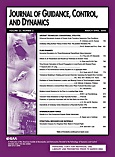
JOURNAL OF GUIDANCE CONTROL AND DYNAMICS
Scope & Guideline
Exploring New Frontiers in Dynamics and Aerospace
Introduction
Aims and Scopes
- Guidance and Navigation Systems:
Research related to the design and optimization of guidance algorithms for various aerospace applications, including spacecraft trajectory planning, missile guidance, and UAV navigation. - Control Systems Engineering:
Development and implementation of control strategies for maintaining stability and performance in dynamic systems, particularly in aerospace contexts such as flight control systems and robotic spacecraft. - Trajectory Optimization:
Focus on methodologies for optimizing trajectories for spacecraft, aircraft, and other vehicles, considering constraints such as fuel efficiency, time, and safety. - Dynamic Modeling and Simulation:
Innovative techniques for modeling the dynamics of aerospace systems, including the effects of uncertainties and perturbations in various environments. - Autonomous Systems and Robotics:
Exploration of autonomous control systems for spacecraft and aerial vehicles, emphasizing machine learning and adaptive control strategies. - Safety and Robustness in Control:
Research aimed at ensuring the safety and reliability of control systems, particularly in the presence of uncertainties and disturbances. - Collaborative and Cooperative Control:
Studies on multi-agent systems and cooperative strategies for tasks such as formation flying and coordinated maneuvers among multiple vehicles.
Trending and Emerging
- Machine Learning and AI in Control:
The integration of machine learning and artificial intelligence in control systems design is on the rise, with applications ranging from adaptive flight control to predictive maintenance and anomaly detection. - Autonomous Systems and Robotics:
A growing focus on autonomous systems, including drones and robotic spacecraft, emphasizes the development of advanced algorithms for navigation and control in unstructured environments. - Resilience and Robustness in Systems:
Research on resilient control systems that can adapt to unexpected disturbances and maintain functionality is gaining momentum, reflecting a broader trend towards safety and reliability. - Sustainable and Green Technologies:
There is an increasing emphasis on sustainable aerospace technologies, including energy-efficient flight systems and environmentally friendly propulsion methods, driven by global sustainability goals. - Collaborative Multi-Agent Systems:
The study of collaborative and cooperative strategies among multiple autonomous agents, such as formation flying and swarm robotics, is becoming more prominent in the literature. - Real-Time and Adaptive Control:
Emerging methodologies for real-time adaptive control systems are gaining traction, enabling systems to adjust dynamically to changing conditions and requirements.
Declining or Waning
- Traditional Control Methods:
There has been a notable decline in the publication of papers focused on classical control techniques, such as PID controllers, as newer adaptive and learning-based methods gain traction. - Basic Astrodynamics:
Research centered on foundational astrodynamics concepts appears to be waning, possibly as more complex and practical applications are prioritized over theoretical explorations. - Static System Analysis:
The emphasis on static analysis methods, which do not account for dynamic changes in systems, has decreased as the field shifts towards more dynamic and real-time approaches. - Non-Autonomous Systems:
There is a diminishing focus on non-autonomous and manually controlled systems in favor of fully autonomous and intelligent systems that incorporate advanced technologies. - Linear Control Theory:
Interest in linear control theory is declining as researchers increasingly explore nonlinear control strategies that offer greater flexibility and robustness in real-world applications.
Similar Journals
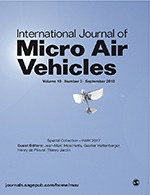
International Journal of Micro Air Vehicles
Pioneering the Future of MAV TechnologyThe International Journal of Micro Air Vehicles, published by SAGE Publications Ltd, stands as a pioneering platform for cutting-edge research in the rapidly evolving field of micro air vehicle (MAV) technology. With an ISSN of 1756-8293 and an E-ISSN of 1756-8307, this journal caters to a diverse readership, including aerospace engineers, researchers, and industry professionals who are at the forefront of innovation in aerospace engineering. It holds a commendable position within the Q3 category of Aerospace Engineering for 2023 and is ranked 65th out of 153 in Scopus, placing it in the 57th percentile among its peers. As a vital resource since its inception in 2010, the journal emphasizes advancements in design, performance, and applications of MAVs, while facilitating knowledge sharing and collaboration across disciplines. Although it operates on a subscription model, the journal ensures accessibility of pivotal research findings for professionals and scholars alike, aiming to shape the future of aerospace applications through rigorous academic inquiry.
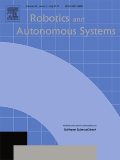
ROBOTICS AND AUTONOMOUS SYSTEMS
Shaping the Landscape of Robotics and Automation.ROBOTICS AND AUTONOMOUS SYSTEMS, published by Elsevier, is a leading journal in the fields of robotics and automation, providing a platform for the dissemination of high-quality, peer-reviewed research. With an impressive impact factor and a prestigious reputation, this journal is classified in the Q1 category for major fields including Computer Science Applications, Control and Systems Engineering, Mathematics, and Software as of 2023. The journal boasts an extensive archive dating back to 1988, reflecting the evolution of the discipline and fostering innovative research discussions that are crucial for advancements in autonomous technologies. Researchers, professionals, and students are encouraged to contribute to and benefit from the ongoing dialogue within these dynamic fields. Accessible through various academic resources, ROBOTICS AND AUTONOMOUS SYSTEMS stands as a pivotal information source for those dedicated to exploring the frontiers of intelligent systems.

JOURNAL OF INTELLIGENT & ROBOTIC SYSTEMS
Exploring Innovations in Intelligent RoboticsJOURNAL OF INTELLIGENT & ROBOTIC SYSTEMS, published by Springer, is a premier interdisciplinary journal that focuses on the rapidly evolving fields of artificial intelligence, robotics, and their applications across various engineering domains. With an impressive impact factor and ranked in the Q1 and Q2 quartiles of multiple relevant categories—including Electrical and Electronic Engineering, Control and Systems Engineering, and Mechanical Engineering—this journal is essential for researchers, industry professionals, and graduate students seeking to stay at the forefront of innovation in intelligent systems. The journal publishes high-quality research articles, reviews, and technical notes that contribute to advancing theory, practice, and the integration of intelligent robotic systems better suited to meet contemporary challenges. Founded in 1988, and with a robust indexing in Scopus, the journal continues to foster scholarly discourse and serves as a critical resource for those passionate about the future of intelligent technologies, despite not currently providing open access options.

Evolving Systems
Unleashing Potential in Evolving Systems ResearchEvolving Systems, an esteemed journal published by Springer Heidelberg, focuses on advancing the interdisciplinary field of evolving systems, encompassing areas such as computer science applications, control and optimization, control and systems engineering, and modeling and simulation. Since its inception in 2010, the journal has made significant contributions to the academic community, currently holding a commendable Q2 ranking across multiple categories for the year 2023. With an impactful focus on the dynamic behaviors of systems and their adaptive methodologies, Evolving Systems serves as a crucial platform for researchers, professionals, and students aiming to explore and expand the boundaries of system evolution. Despite being a subscription-based journal, it remains committed to fostering high-quality research dissemination and encourages submissions that push the envelope of knowledge in this rapidly developing field. The journal employs a rigorous peer-review process, ensuring the publication of cutting-edge research that meets the highest scholarly standards.
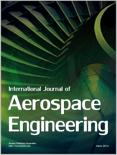
International Journal of Aerospace Engineering
Exploring New Frontiers in Aerospace TechnologyThe International Journal of Aerospace Engineering, published by HINDAWI LTD, stands at the forefront of innovation and research in the field of aerospace engineering. With an impact factor reflecting its contributions to the discipline and classified in Quartile 3 (Q3) for the year 2023, this journal provides a platform for high-quality, peer-reviewed articles that delve into advancements and challenges in aerospace technology and applications. Since its inception in 2008, the journal has embraced an Open Access model, promoting unrestricted dissemination of research findings to foster collaboration and knowledge sharing among researchers, professionals, and academia. The journal covers a broad spectrum of topics, aiming to enhance understanding and give insight into aerospace engineering's multifaceted aspects. With its coverage in the Scopus database, ranking 71 out of 153 in the aerospace engineering category, the journal is a valuable resource for those engaged in this dynamic field, ensuring that high-impact research receives the visibility it deserves.
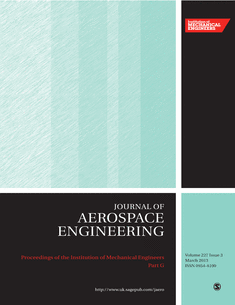
PROCEEDINGS OF THE INSTITUTION OF MECHANICAL ENGINEERS PART G-JOURNAL OF AEROSPACE ENGINEERING
Pioneering Insights in Aerospace EngineeringPROCEEDINGS OF THE INSTITUTION OF MECHANICAL ENGINEERS PART G-JOURNAL OF AEROSPACE ENGINEERING, published by SAGE PUBLICATIONS LTD, stands as a pivotal resource for those immersed in the disciplines of aerospace and mechanical engineering. With an ISSN of 0954-4100 and E-ISSN of 2041-3025, this journal not only contributes to the academic community but also reflects a robust commitment to advancing knowledge within these fields. Operating from the United Kingdom, it has garnered a respectable reputation, evidenced by its category quartiles—ranking Q3 in both Aerospace Engineering and Mechanical Engineering as of 2023. Established in 1989, the journal has evolved substantially over the years, serving as a platform for groundbreaking research and innovative methodologies. Researchers, professionals, and students alike will find a wealth of insights that foster collaboration and advance the frontiers of engineering. Although currently not available as an Open Access publication, the journal remains a critical reference point for those looking to deepen their understanding and contribute to ongoing developments in aerospace technology.

Journal of Systems Science & Complexity
Illuminating the Dynamics of Complexity in Technology and Beyond.The Journal of Systems Science & Complexity, published by SPRINGER HEIDELBERG, stands as a leading forum for innovative research in the fields of computer science and information systems. With an ISSN of 1009-6124 and an E-ISSN of 1559-7067, this journal has established itself within the academic community, garnering a commendable impact factor that reflects its influential contributions. Operating from 2006 and continuing through 2024, it is categorized in the Q2 quartile for both Computer Science (Miscellaneous) and Information Systems, indicating its quality and relevance. Recognized within Scopus rankings, it places 52nd out of 133 in its specific field, affirming its significance in advancing systems science discussions. Researchers and professionals will find a wealth of knowledge through rigorous peer-reviewed articles that explore complex systems and their applications, enabling readers to stay at the forefront of technological advancements and interdisciplinary collaboration.
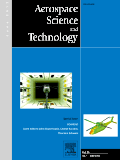
Aerospace Science and Technology
Elevating Research to New HeightsAerospace Science and Technology, published by ELSEVIER FRANCE-EDITIONS SCIENTIFIQUES MEDICALES ELSEVIER, is a leading journal in the field of aerospace engineering, boasting an impressive 2023 Q1 ranking and a significant position in the Scopus Ranks, where it stands at Rank #7 out of 153 in the Engineering - Aerospace Engineering category, reflecting its credibility and impact with a 95th percentile ranking. Since its inception in 1997, this journal has provided a robust platform for the dissemination of pioneering research and advancements in aerospace technology, focusing on innovative methodologies and applications in the aerospace sector. With a commitment to open access, researchers, professionals, and students can easily engage with cutting-edge findings that drive the industry forward. The journal not only seeks to expand knowledge but also aims to foster collaboration among scholars across the globe, making it an essential resource for anyone looking to stay at the forefront of aerospace innovation. For more information, visit its website or refer to its dedicated address at 65 Rue Camille Desmoulins, CS50083, 92442 Issy-Les-Moulineaux, France.

AERONAUTICAL JOURNAL
Elevating the standards of aerospace scholarship.Aeronautical Journal, published by Cambridge University Press, is a premier scholarly journal dedicated to advancing the field of aerospace engineering. With a notable impact factor, this journal holds a strong position in the academic community, ranked #53 out of 153 in the Scopus category of Aerospace Engineering, placing it in the 65th percentile. The journal has been providing a platform for groundbreaking research since its inception in 1969, and continues to be a vital resource for researchers, professionals, and students involved in aeronautics. As a Q2 journal in the 2023 Aerospace Engineering category, it offers high-quality articles that cover a range of topics within the discipline, contributing to the ongoing discourse and innovation in aerospace technologies. Although not an open-access journal, it remains accessible to a vast readership through institutional subscriptions and partnerships. The Aeronautical Journal is a crucial publication for those seeking to stay at the forefront of aerospace research and development.

INTERNATIONAL JOURNAL OF ROBUST AND NONLINEAR CONTROL
Advancing Control Systems for a Complex WorldINTERNATIONAL JOURNAL OF ROBUST AND NONLINEAR CONTROL, published by Wiley, is a leading journal in the fields of Aerospace Engineering, Biomedical Engineering, Chemical Engineering, Control and Systems Engineering, Electrical and Electronic Engineering, Industrial and Manufacturing Engineering, and Mechanical Engineering. With an impressive range of categories all ranked in the Q1 quartile as of 2023, this journal serves as a pivotal platform for disseminating high-quality research focused on robust and nonlinear control methodologies. Researchers and practitioners benefit from its comprehensive scope, which includes theoretical advances, algorithm development, and practical applications. The journal's commitment to fostering innovation in control systems is reflected in its notable Scopus rankings across various engineering disciplines, ensuring your work reaches a wide audience. Emphasizing the importance of collaboration in interdisciplinary contexts, the INTERNATIONAL JOURNAL OF ROBUST AND NONLINEAR CONTROL is essential for both seasoned researchers and newcomers in the engineering community, providing a vital resource for advancing the frontiers of knowledge in control systems.